There’s really nothing like taking a bite of a perfectly cooked steak. It’s tender, it’s juicy, it’s bursting with flavor. It’s a special taste and often for a special occasion. Sous vide is the technique that guarantees the perfection you strive for, every time.
The entire steak is uniformly cooked through. The outside has a crust on it and it easily slices through with a knife revealing that ideal medium-rare interior. The flavor is perfect and the texture melts in your mouth. It’s unmistakable. You have one of the best mouth-watering bites possible at that moment.
On a grill or stove, more often than not, your steak is going to come out a little over- or undercooked from what you were going for. And even if the temperature is nailed in the middle, there is likely that dreaded gray ring around the edge.
Sure, we all get it right some of the time, but it takes a lot of practice to get a perfect cook every single time. That is, unless you are cooking your steak with the sous vide method.
What Does Sous Vide Cooking Mean?
Sous vide is a
The food (steak in this case) is vacuum-sealed in a plastic bag, then that bag is submerged in a temperature-controlled water bath for a period of time that perfectly cooks it all the way through to the same temperature. Once it is cooked, you sear it in a pan to give it a flavorful exterior.
While the sous vide cooking technique has been around for quite a long time, it’s only recently becoming a method that is commonly used in home kitchens because of the accessibility of consumer sous vide machines.
Why Sous Vide Steak?
Cooking steak with the sous vide method will yield perfect results every time. Whether you prefer your steak rare, medium, well-done or anywhere in between, there is no guessing as to when your steak reaches the exact temperature you want it to.
- All the guesswork is eliminated. Set the temp and the time and the rest of the work is done for you right in the water bath. No matter the size or thickness of the steak, it will come out to the temperature you specified. That means if you have a 2-pound T-bone and an 8-ounce filet mignon, they will both come out perfectly medium-rare at the same time. Pretty amazing, right?
- No risk of overcooking. It is cooked to the exact temperature you specify through the entire steak.
- Cook one or many steaks and the process and time is the same.
- Perfect for entertaining because it’s hands-off! Spend time entertaining your guests rather than hovering over the stove. The amazing thing about sous vide for steaks is they can be cooked to the perfect temperature ahead of time (like way before your guests even arrive), then quickly sear them off right before serving. This makes for stress-free entertaining while executing perfect food (and this is how restaurants do it).
- It’s great for meal prep! You can sous vide your steak up to a week ahead of time and then just sear it in a skillet just before you are ready to eat.
- Make it a “Steak Sampler” Dinner Party! Go pick up a New York strip, a rib-eye and a filet mignon. Everyone can taste to see how the flavors and textures of each cut differ and pick their favorite.
Choosing the Best Steaks for Sous Vide
It is best to go with a larger, thicker steak if possible. If you are making steak for two, get one large steak instead of two smaller individual-size steaks.
The reason that thicker is better is that the steaks are first cooked in the water bath, then quickly seared to develop a flavorful crust on the outside. If the steak is really small and thin, it can overcook during the sear before it is fully browned.
Cut: Any cut will work. Rib-eye, New York and filet mignon are the most popular. T-bone, porterhouse and even a whole prime rib roast will work great as well.
Thickness: Go with a steak that is at least 1-inch thick, but thicker is even better.
Size: 12 ounces and larger (this will get sliced and served to multiple people).
Grade: Prime or Choice Grade.
Ingredients You’ll Need
- Steak – See how to choose the best steak above.
- Salt – I prefer Diamond Crystal kosher salt but use whatever you prefer. You can even use some smoked salt to add a slightly smoky flavor to the steak.
- Pepper – Simple black pepper is great.
- Aromatics such as a few thyme sprigs are totally optional but do add a nice flavor.
Equipment Used
- Sous vide machine (immersion circulator)
- A large container for the water bath. A large pot can work great, too.
- Vacuum sealer (optional)
- Vacuum seal bag (optional) or Ziplock freezer bag
- Weighted magnets or bag clips for keeping the bag submerged.
- Heavy skillet for searing the steak.
- Tongs for placing the steak in the water bath and for turning in the skillet.
How to Sous Vide Steak – Step by Step
Now that you’ve got your equipment and ingredients ready, let’s go through the simple steps to cook steak sous vide.
Step 1: Choose Your Desired Temperature
Preheat the water bath with your sous vide machine to the temperature you want your steak cooked. Use 130° F (54.4° C) for a medium-rare cooked steak. You can go less or more depending on your specific preference.
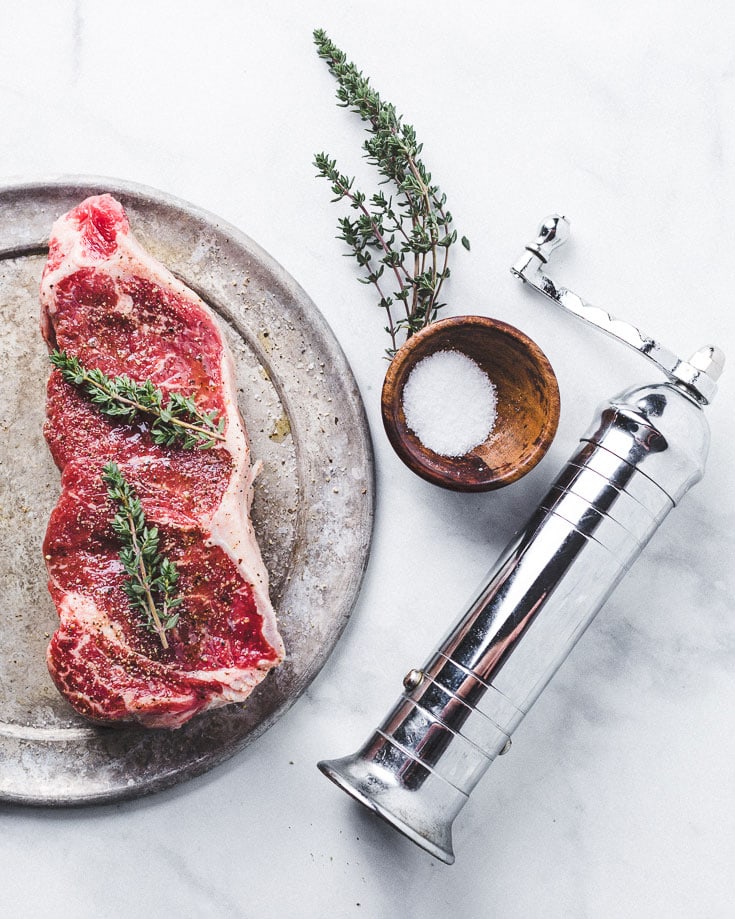
Step 2: Season the Steak
Liberally season all sides with plenty of kosher salt and pepper. Place a few thyme springs on each side of the steak, if desired.
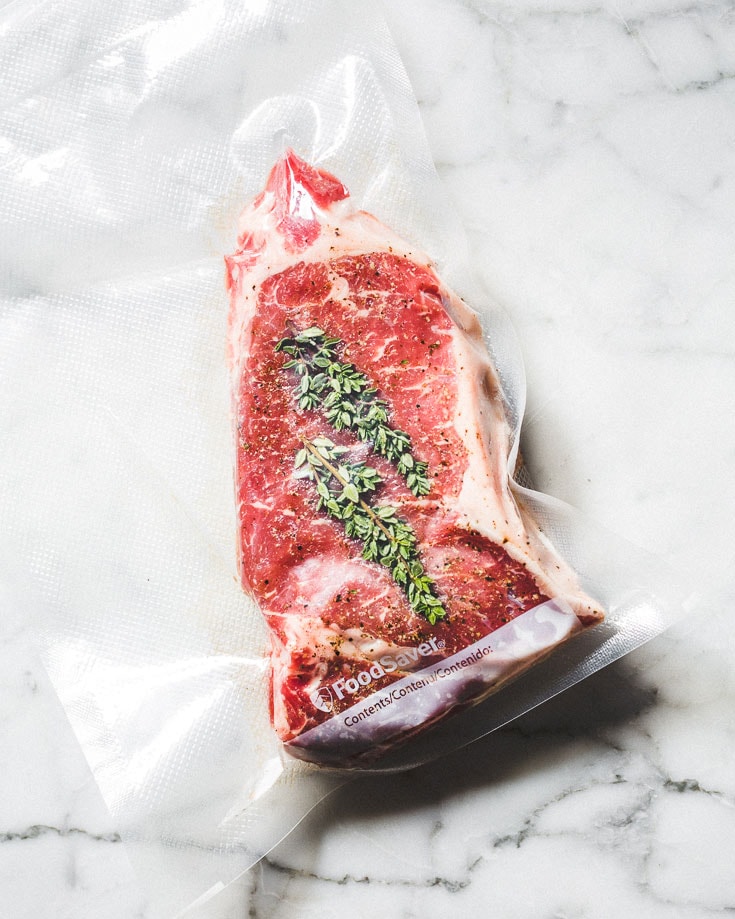
Step 3: Vacuum Seal
Place the steak in a vacuum-seal bag and vacuum seal, removing all the air. *If you don’t have a vacuum sealer, you can use a Ziplock freezer bag and use the water displacement method to remove the air and seal the bag.
To use the water displacement method using a Ziplock bag: Partially seal the bag and remove as much air as possible, then partially submerge the bag into the water (always keeping the opening above the water line) and let the pressure push the air out. Seal the bag just before reaching the water line.
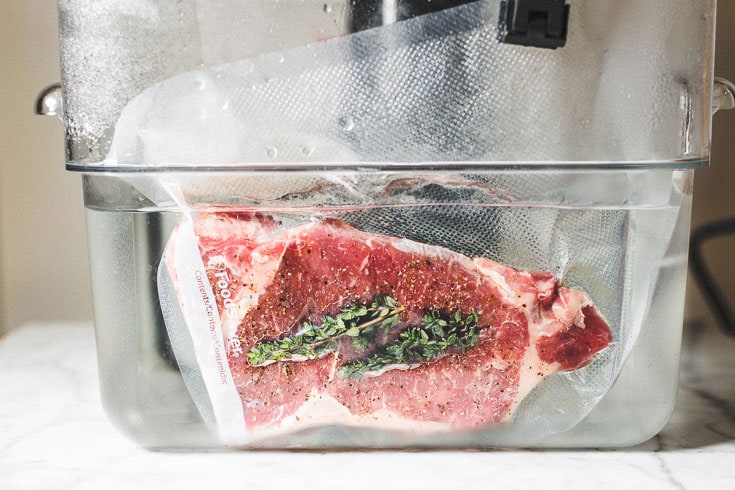
Step 4: Cook the Steak
Submerge the sealed bag in the water bath and cook for 1 to 3 hours. Be sure that the steak is completely below the surface to ensure even cooking. Any air pockets can cause it to float. Use a clip or magnets to hold it in place.
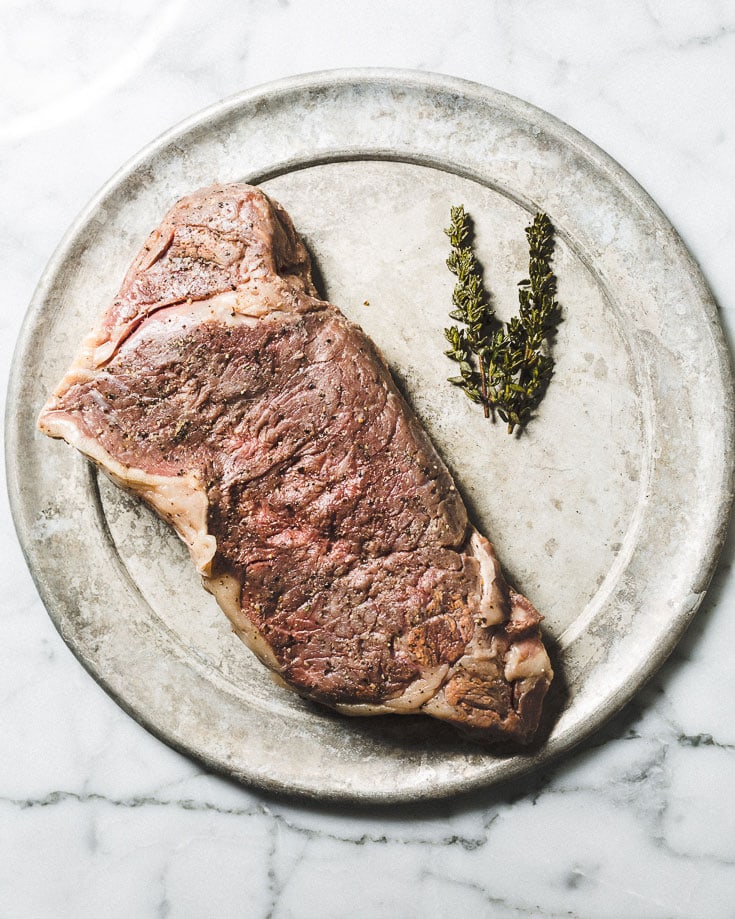
Step 5: Remove from the Water Bath
Remove the cooked steak from the water bath and place on the counter still vacuum sealed for 10 to 15 minutes to cool slightly before searing. You can also refrigerate the steak in the bag and keep it for up to 1 week.
Step 6: Remove the Steak from the Bag
Pat the steak as dry as possible with paper towels, which helps get a better sear.
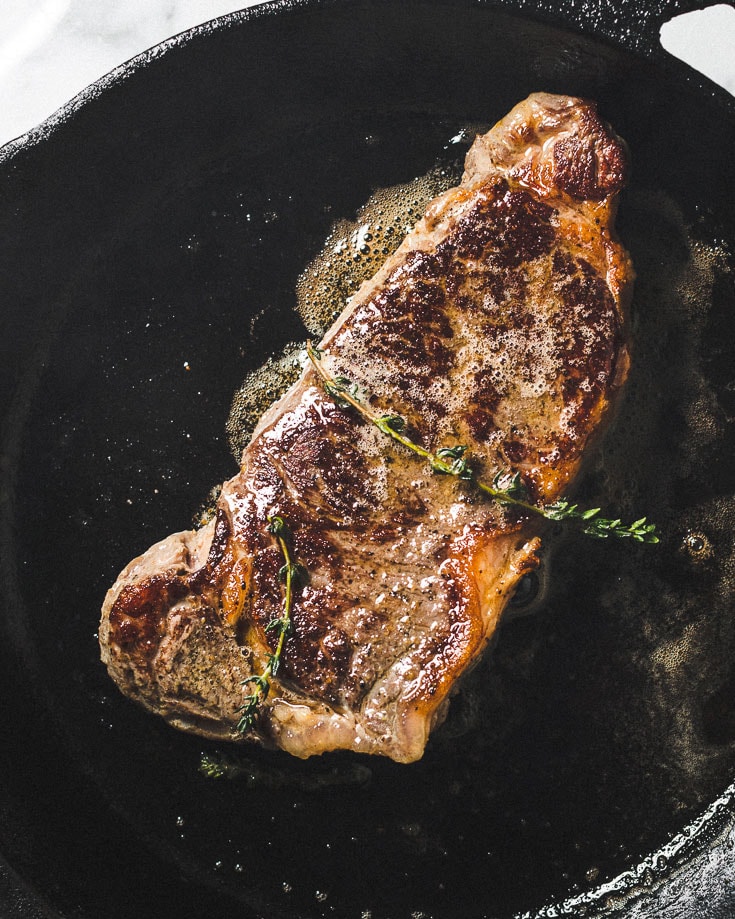
Step 7: Finish with a Quick Sear
Heat a heavy cast-iron skillet over high until it’s just starting to smoke, then drizzle in enough neutral oil to coat the bottom of the pan. Add the steak and sear for 30 seconds to 1 minute per side until golden brown. Don’t sear the steak for longer or it will start to raise the internal temperature.
Tip: Baste the steak with butter by adding a few tablespoons of butter, smashed garlic cloves and thyme sprigs to the pan after the steak is in the pan. Use a large spoon to baste the browning butter on the steak. This will add extra flavor and help develop a golden crust.
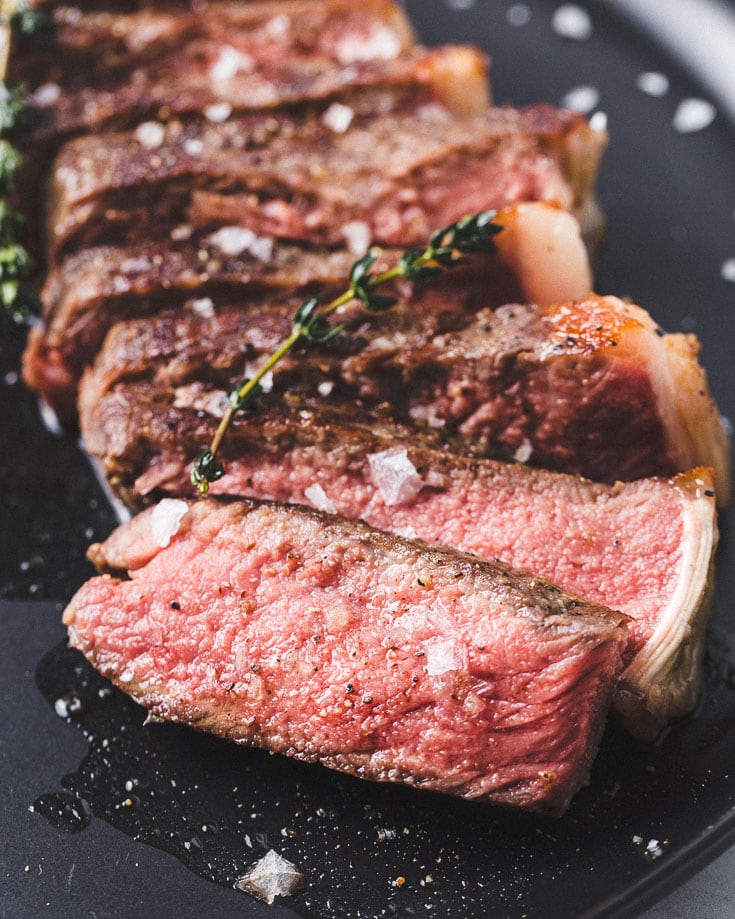
Step 8: Slice and Serve
Using a sharp knife, slice the steak against the grain and serve immediately. There’s no need to rest a steak that has been cooked sous vide.
Sous Vide Steak Temperatures
Since we’re cooking the steak sous vide, there’s no need for a temperature range to shoot for, like there is when cooking steak with traditional methods. With sous vide, it’s an exact science, so you can just set it to the exact temp you want and forget it (until it’s done). 🙂
The perfect medium-rare temperature for steak is 130° F or 54.4° C. You can go up or down a degree or two depending on your preference. It’s great to experiment with different temperatures to find out what you like, and it might vary depending on the cut of steak you are cooking.
Cooking Temperatures and Times for Sous Vide Steak
| Doneness | Water Temp | Time |
|---|---|---|
| Rare | 125° F / 51.6° C | 1 to 3 hours |
| Medium Rare | 130° F / 54.4° C | 1 to 3 hours |
| Medium | 140° F / 60° C | 1 to 3 hours |
| Well Done | 160° F / 71° C | 1 to 3 hours |
How to Finish & Sear Your Sous Vide Steak
Cooking the steak sous vide gets you 95% of the way, but there’s still the all-important sear to develop a flavorful crust on the outside. The searing step isn’t one you want to overlook. You have multiple options from searing in a skillet to using a torch.
Not only is it the most exciting step, but it happens very quickly and the steaks can easily overcook if left in the pan too long. Make sure the surface of the steak is as dry as possible so they sear instead of steam.
Since we’re searing at a super-high temperature and there is some fat involved, which will produce smoke, there is an advantage to taking your searing outside.
- The Skillet Method: This is generally the go-to method because it is the most convenient and provides great results. Just heat a heavy bottom skillet (such as cast iron or carbon steel) over high heat, add some neutral oil and sear for about 1 minute per side.
- On the Grill: If your grill is already going, searing your steak there is a no-brainer. You want it as hot as possible to avoid the steak from taking too long to sear. I don’t really find it worth lighting the grill just to sear a sous vide steak.
- Charcoal Chimney Starter: Filling a chimney starter halfway with charcoal and getting the coals super hot with the grill grate right on top is a super hot way to get a quick sear, with minimal charcoal usage.
- With a Torch: There are numerous high-intensity gas torches out there for searing foods. I have a Bernzomatic TS8000 and use MAP-Pro fuel, but there are sous vide specific devices you can find. You will basically run the flame along the steak until it forms a seared crust. The results can be delicious, but it can take a little longer than a pan sear.
- In the Smoker: You can actually smoke your steak after it is cooked sous vide. Fully chill it down in an ice bath, then warm it up in your smoker at the lowest temperature possible (200° F or lower) until the internal temperature of the steak reaches 115° F. After the smoke flavor is added, you can sear it on the grill or in a pan.
FAQs
A 1-inch-thick steak should be cooked sous vide for a minimum of 1 hour and up to 3 hours. That’s right! You have that big window of time in which you can do other things and your steak will come out perfect whenever you remove it from the water bath within that window of time.
Yes! You absolutely can sous vide a frozen steak. In fact, it’s great to prep your steaks, vacuum seal and store them the freezer until you want to eat them. No need to defrost them. Just add 1 hour to the cooking time for them to fully defrost.
It’s super easy to cook steaks at different temperatures using sous vide. Set for the higher temp doneness and cook for at least 1 hour. Then lower the temperature of the water bath (you can add some ice to speed it up) and add your second steak and cook for another 1 to 2 hours. That makes it easy to make both medium and medium-rare steaks with the same water bath.
More Sous Vide Recipes to Try
- Sous Vide Mashed Potatoes
- Sous Vide Pork Chops
- Sous Vide Chicken Breast
- Sous Vide and Smoked Prime Rib
- Smoked Sous Vide Chuck Roast
- View all the sous vide recipes
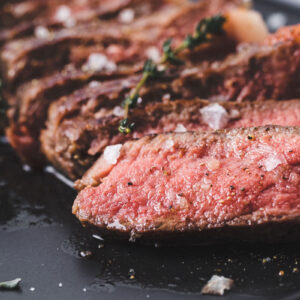
Sous Vide Steak
Equipment
Ingredients
- 1 steak (at least 1" thick)
- Kosher salt
- Black pepper
- 2 fresh thyme sprigs
For searing the Steak
- 1 tablespoon neutral oil, such as canola or vegetable oil
- 1-3 tablespoons butter
Instructions
- Set up your sous vide cooker: Fill your sous vide container or large pot with water and turn on the sous vide machine and set the temperature according to the manufacturer's instructions to 130° F (54.4° C) for medium-rare, or to the desired finished temperature.
- Season the steak: Liberally salt all sides of the steak with kosher salt and pepper. Place a few thyme sprigs or other aromatics on the steak if desired.
- Vacuum seal the steak: Place the steak in a vacuum seal bag or Ziplock bag and vacuum seal the bag if using a vacuum sealer. If using a Ziplock bag, partially seal it after removing as much air as possible, then use the water displacement method by placing the bag in the water (always keeping the opening above the water line) to push the rest of the air out before sealing it.
- Cook the steak: Fully submerge the bag in the water bath, clipping it to the side of the container to keep it in place, then cook for 1 and 3 hours for a 1-inch-thick steak.
- Remove the bag from the water bath and let the steak sit on the counter in the bag for 10 to 15 minutes to cool slightly before searing.
- Remove the steak from the bag and pat dry with paper towels.
- To sear the steak in a skillet: Heat a cast-iron skillet over high heat until it just starts to smoke. Drizzle enough oil to coat the bottom of the pan and let that heat up for a few seconds.Place the steak in the skillet and sear for about 30 to 60 seconds on each side until golden brown. Going longer than 1 minute on each side can cause the steak to cook more than desired.
- Optional: To butter-baste the steak during the sear, add up to a few tablespoons of butter along with thyme sprigs and crushed garlic cloves after the steak is searing. Once the butter melts, begin basting it over the steak with the thyme until finished with the sear.
- Slice and serve immediately with a sprinkle of finishing salt, if desired. There's no need to rest sous vide steak.
Video
Notes
- The recipe makes 1 steak, but can easily be scaled up for more. You can vacuum-seal steaks in the same bag (side by side) or in separate bags.
- If the steak isn’t staying submerged, you can place a bowl or plate on top of it to keep it down.
- Cook temperatures:
- Rare – 125° F (51.6° C)
- Medium Rare – 130° F (54.4° C)
- Medium – 140° F (60° C)
- Well Done – 160° F (71° C)

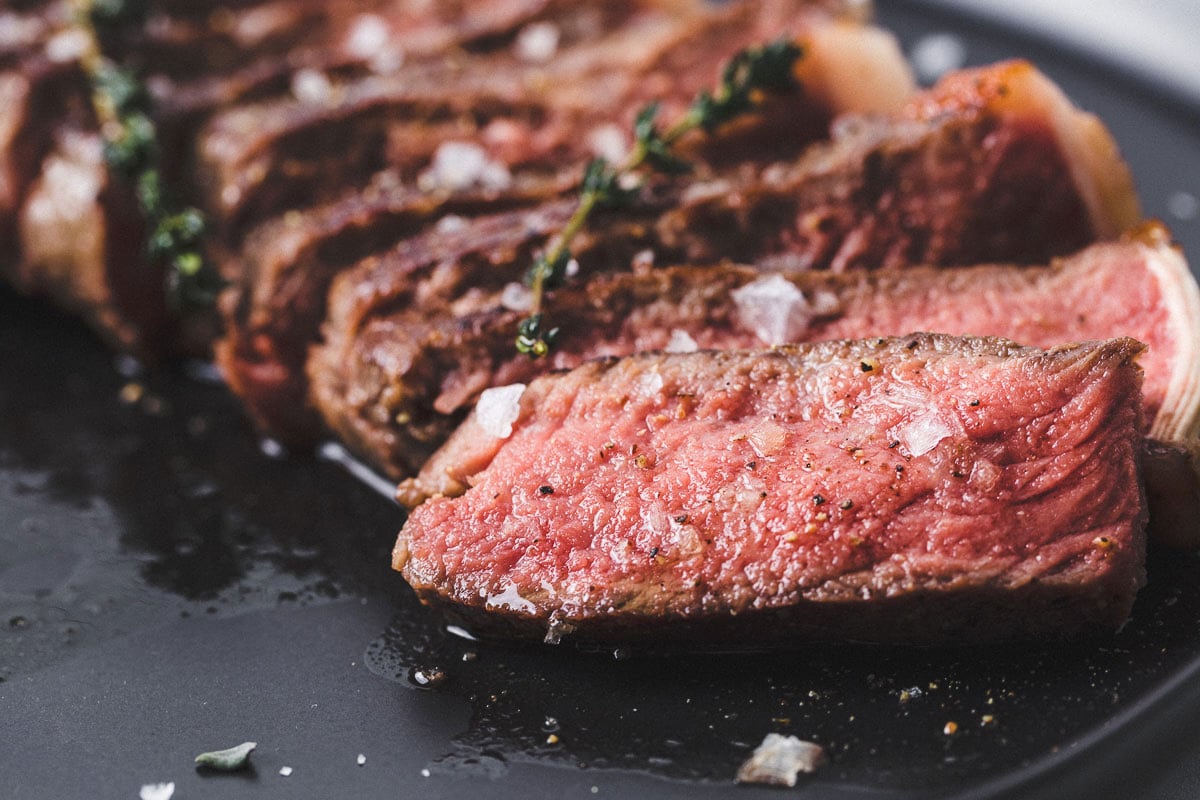
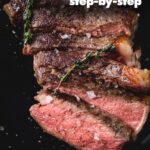
This was delicious! The most tender and delicious steak I have ever made!
I would say that my garlic pretty much overly browned during the searing phase. Any way to correct that?
So glad to hear it came out so wonderful for you!
Sounds like you had some nice high heat for the sear. That makes a big difference.
If the garlic is getting too dark, you can sear the first side, then reduce the heat after flipping and add the butter, herbs and garlic. You won’t get quite the same sear on the second side, but all that flavor will help to make up for it.
Hi Justin,
This is so exciting, that I cannot wait to buy my first Sous Vide device. Great Recipe and great exchange of opinions, advice, etc.
One question if you would please: “Can I freeze for a future searing the steaks after Sous Vide cooking them?
Even can I freeze them in the same vacuum bag used for Sous Vide cooking? Also please, how long do I have to defrost them for before searing?
Thank you for a fantastic recipe, advise, and dedication – regards,
Oscar
I’m excited for you, Oscar! To answer your question: Yes, you absolutely can freeze for future searing after you sous vide them. This is great to do for meal prep or for going camping. Don’t unseal the bag after you cook them sous vide. Just keep them in it so they stay pasteurized.
The time it takes to defrost them will depend on the size of the steak and other temperature factors. You can defrost them in the water bath if you wish.
Let me know if you have any other questions.
Hey! Thanks for all the insight…I’m excited to try this technique. We will be taking a trip with friends, and I am wondering if I can sous vide our steaks at home, refrigerate them still vacuum sealed, and then grill/sear them at the cabin a couple of days later? If yes, I’m assuming I should let them come to room temp first? Thank you
Hey Kimberly! Absolutely. That’s one of the huge advantages and great uses of the sous vide technique. You can cook your steaks ahead of time then cool them quickly and store them sealed in the bag until you need them (good for about a week). If they are really thick steaks, then you can let them come to room temperature. But if they are on the thinner side, I would sear them cold as to not overcook them. Let me know if you have any other questions. Have a great trip!
HOw do you know when it has been in long enough? 1-3 hrs is quite a wide window of time !
That simple to cook the most delicious perfect steak every time.
Hi Richard. Yep, you can sous vide right from the refrigerator. There’s no need to temper the steaks when cooking sous vide. You could even cook straight from the freezer, but extra time will have to be added. Cheers!
Can the steak (assume 2″ thick filets) be cooked straight from the refrigerator (approx 34 degrees F) or does it need to sit out for a while so that you are starting with meat closer to room temperature?
Thrilled to hear that it came out perfect the first time trying it. That’s the goal! Keep on experimenting with Sous Vide. It’s so fun. Enjoy!
This is my first time making Sous Vide Steak. The great thing is that I have read your recipe. Everything is very perfect. Thanks you!
oh. Actually cooking steak is not as difficult as I thought. Following your recipe, I made a great steak. So delicious. Thank you!
I have made outstanding steaks out of top round london broil on sale.. I usually use 129 and cook from 2 to 3 hours. When cooking at sub-pasteurization temps, the searing is especially important for safety – to kill the germs on the surface of the meat, where they are usually found. If I have my druthers, first choice in searing is on the grill with a 100% mesquite fire. Second choice outside on a gas stove with the stove and a torch. Last is on the kitchen stove, but still very good.
Rather than butter basted, I like to cook a couple mushrooms with a little garlic and butter, allow to cool. Put 8 ounces or more of heavy cream into the food processor and let it rip until it’s butter. Do NOT salt the butter until after you pour off the buttermilk, which you can then drink or save. Add the cool mushrooms and process to incorporate the shrooms with the butter. This adds great umami flavor to the beef. with a pat put on just before eating. This can be frozen and used whenever, allowing for some warming time, or a very brief nuke if you forget.
OMG, that mushroom sauce sounds to die for. I’m definitely going to give it a try.
How much of the mesquite smoke flavor gets into the steak when it’s just a quick sear?
Thanks for adding your great tips!
If you can get some maitake mushrooms, just an ounce will do, that butter will really sing umami.. Maitake, aka hen-of-the-woods, is a strong flavored fall shroom that does this the best. Only an ounce of it will do 8 ounces or so of butter..
Maitake can be allergy-causing for some people, but it’s the best for this butter.
Hey Isaac. Oh no! What kind of oil did you use and what type of pan? Any idea what temp the pan was? I almost always put the oil in after pre-heat because the oil can be degraded by the time the pan heats up. I haven’t had an issue, so I’d love to hear more info so we can figure it out.
Glad to hear the steak turned out amazing, but sorry about the rest.
I almost burnt my house down adding the oil (: def should reword the searing step one around… maybe say add oil then heat? Cause I heated on high then added the oil and kaboom literally almost sh** myself lol. But if turned out amazing regardless after I retried the searing! Did burn my hand thou :/
Hi Marie! Yep, you totally can. I recommend that you first cook the steak that you want to be done at a higher temperature. Then lower the temp of the water bath (you can add a little ice to do this quickly) and then add your second steak to the water bath. Cook that while leaving the first steak in the water bath so it stays warm. Sear them both as you normally would. Cheers!
my son likes rare and I like med/well. Do I sous vide together at rare temp then remove his and turn up temp on mine? or does it take a long time to up the temp?
Hi Tami,
Great question and one that I need to make a separate post about. The way to do it is similar to what you describe, but reversed. First sous vide the med/well steak (around 140 to 145°F) for 1 hour, then lower the temperature of the water to the rare temp. You can put ice in a plastic bag and lower that into the water bath to quickly lower the temperature. Sous vide the rare steak as you would and leave the med/well steak in the water to stay warm. Hope this helps!
Cheers,
Justin
No finishing with a blowtorch?
Good point, Igor. I do need to add that method. Thanks!
Cooked to absolute perfection! Melt in your mouth goodness.
Yay! So glad it came out perfect!